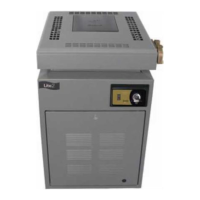Page 12
CAUTION
Some leak test solutions (including soap and
water) may cause corrosion or stress cracking.
Rinse the piping with water after testing.
ATTENTION
Certaines solutions d’essai d’étanchéité (y
compris l’eau et le savon) peuvent causer de la
corrosion ou de la fissuration. Rincez les
tuyaux à l’eau après l’essai d’étanchéité.
4.2 Manifold Pressure
Confirm that gas supply pressure is correct. If
the gas supply pressure is less than required, check for
undersized pipe between the meter and the heater, a
restrictive fitting, or an undersized gas meter. Gas
supply pressures to the heater, when it is operating,
are listed in Table 5.
CAUTION
Manifold gas pressure for the Lite2 LJ natural
gas heaters should be set at 4" WC. Propane
heaters should be set to 9" WC.
ATTENTION
La pression du collecteur de pression pour les
systèmes de chauffage au gaz naturel devrait
être de 4'’ WC. Pour les sytèmes de chauffage
au gaz propane devrait être de 9'’ WC.
The manifold pressure may be checked by
connecting a manometer to the pressure port on the
outlet side of the valve. You will need to remove the
1/8" NPT protective plug from the port and install the
appropriate 1/8" NPT fitting to connect your manom-
eter. The pressure will be zero when the heater is not
running. When the heater is operating the manifold gas
pressure should be 4.0" WC for natural gas heaters
and 9.0" WC for LP gas heaters.
To adjust the manifold gas pressure, first remove
the slotted cap on the top of the gas valve to the right
of the control knob. Under the slotted cap is a slotted
plastic screw which increases the manifold pressure
when turned clockwise and decreases the manifold
pressure when turned counterclockwise.
After measurements, and adjustments if neces-
sary, have been made, make sure to replace the 1/8"
NPT plug on the manifold pressure ports, and the cap
on the manifold pressure adjustment screw. It is
extremely important to replace these parts before
leaving the installation. Failure to do so can result in
damage to property or injury or death.
With the heater firing, the pressure must be
within the range shown in Table 5. Also check the
pressure with the heater off.
4.3 Special Precautions for Propane Gas
LP Gas is heavier than air and can therefore
more readily collect or “pool” in enclosed areas if
provision for proper ventilation is not made. Installation
of pool heaters in enclosed areas such as pits is not
recommended. However, if such an installation is
required be sure to pay special attention to proper
ventilation for LP gas. Locate heaters a safe distance
Note: When using metal pipe as heat sink, join metal and PVC/CPVC, using metal male and PVC/CPVC female connection.
Figure 7. Typical installation

